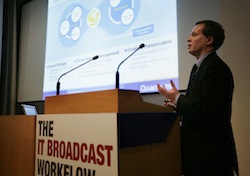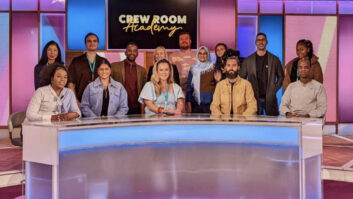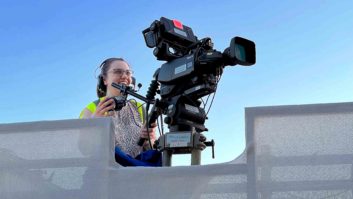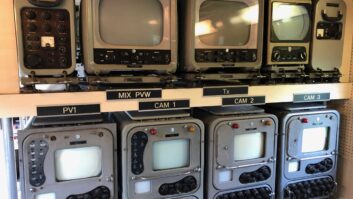
Challenges of current broadcast workflows: convergence can be a good thing – but how can IT help? Session presented by Declan Wood and Alistair Washbourn, software marketing manager EMEA, Quantum Corp.
It is very costly to “just move wholesale from tape to a file-based environment without considering how to make IT work for you,” Declan Wood, managing director, Media Manor, told the conference. Indeed, it isn’t even a matter of getting rid of tape. Because of the use of data tapes, “it is not tapeless, but less tape.”
The primary goal must be to speed up the production process and aid collaboration. As a consultant, he finds that much of the existing process at broadcasters and production companies is file based, but they tend to be islands of production. “There’s not a massive amount of collaboration.”
A standard IT storage area network will give you a consolidated, scalable file store, as seen in many enterprises, and is relatively cost effective, but it is not necessarily suitable for the real-time needs of broadcast or production. You need to get a high-performance file system (the two projects he detailed chose StorNext), and it’s important to have file locking, to give scalable access to your files. Although hard drive costs are reducing, they are still expensive, so you need intelligent storage management that will remove material to near-line or long-term storage at the right time (such as StorNext Storage Manager).
“You need to classify data, so you know when it’s accessed, and apply intelligent rules to decide where it should put content. We can put different storage tiers in place, disk or tape. Putting this sort of solution in place allows us simplify the back up and disaster recovery process, as it can make multiple copies easily.”
To make the most of these systems, he recommends a proxy-based workflow, so that users can work on low-res files without waiting for high-res versions to load (especially if they have already been moved to archive.).
MediaSet, Italy, wanted to ingest and playout HD content in realtime, and needed a very high performance IT system, “but just adding another server didn’t’ expand its collaboration possibilities.” It needed to be able to perform 20 HD ingests and playouts concurrently from its storage pool, so it installed StorNext, with more than 700TB of disks and more than three Petabytes of archive.
“It ended up with software that allowed access to ingest content by multiple people and to archive it, on different storage tiers, and to do disaster recovery.”
Lime Pictures, one of the UK’s largest independent producers, didn’t need the complexity of MAM, and were one of the first in the business to move to tapeless, using standard IT hardware. However, when Lime Pictures went HD, the extra data involved meant it couldn’t back up that content in the time available before requiring the system again. There was also a high management overhead involved – managing the system took up 80-90% of the operator’s time.
This is why it moved to StorNext, “where it could use and enhance existing IT infrastructure and have simultaneous, multi-platform access to that content,” using Final Cut Pro and other systems.
“There was no real net cost to the move to HD, due to the time savings in management, except the cost of the extra disks,” added Alistair Washbourn, Quantum Corp.
“It also meant they could then safeguard these assets by then moving them across to tape and having off-site file storage,” said Wood.
In future “we can start looking at how we can add value to archive and make use of enhanced tape drive diagnostics and automated file-based quality control,” which is necessary to know that archive material is still intact and that files can be transcoded to newer codecs.
He is also enthusiastic about the possibilities for “cloud-based workflow”, which has “some distinct advantages,” especially for use across different organisations, whether sub-contracting out the creation of transcripts or subtitles (which won’t need HD content), or for co-productions. It will make it easier to base the service on a usage model rather than on the technology spend. – David Fox







